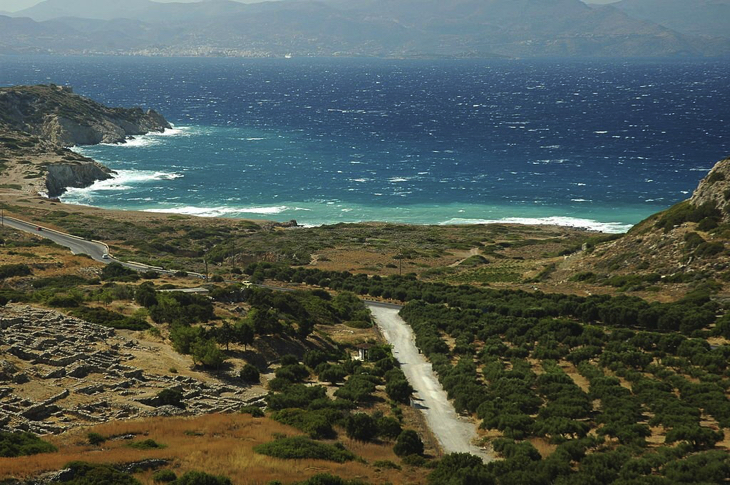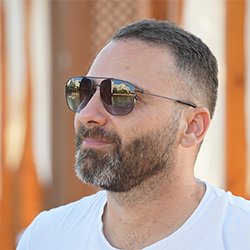The Gournia Archaeological Site is located on the north coast of the Isthmus of Ierapetra in Crete. Found on the site are preserved houses, cobbled streets, a court, a palace, and a cemetery. Gournia Archaeological Site depicts what a town looks like during the Late Bronze Age. Additionally, bronze tools, pottery, and vases can be found on the site as well. The site is deemed to be the most excavated town in Crete. It was founded in 1550 BC but was later destroyed by an earthquake in 1450 BC and was left the way it was in 1200 BC. The site is accessible on the right side of the National Road Agios Nikolaos-Sitia, just a few metres away from Pachia Ammos Village. It is open Tuesday to Sunday from 8:30 A.M. to 3:30 P.M. The entrance costs around €2 for all regular tourists, and €1 for senior citizens and students.
Gournia where the Gournia Archaeological Site is located was discovered in the 20th century by American archaeologist Harriet-Boyd-Hawes. Unknown is the site’s original name. Gournia’s numerous vessels, which are widespread, are whence the modern term is derived. Tourists visit Gournia Archaeological Site because of its great appeal due to its historic structures and archaeological discoveries, which include the artefacts of the town and the palace. Gournia Archaeological Site also has an adjacent tourist destination as well as nearby restaurants that are worthy to visit and try. In 2018 alone, the island of Crete welcomed more than 5 million tourists. Tourists’ itinerary often includes the beach and the mountainous tours but of course, for a historic experience also visit archaeological sites such as Gournia Archaeological Site. For a more exclusive, organised, and time-worthy exploration on the island of Crete especially when visiting archaeological sites, a car rental in Crete is the best option. It will give you ample time to reflect and understand the culture, and appreciate the artefacts, and the history of the place.
What is the history of the Gournia Archaeological Site?
Gournia Archaeological Site was explored by Harriet Boyd in the first decade of the 20th century. Gournia Archaeological Site is one of the few entirely excavated Minoan villages. It was founded in 1550 BC but was later destroyed by an earthquake in 1450 BC and was left the way it was in 1200 BC. The settlement’s original name is unknown, but its current name derives from the numerous hollow containers that were discovered on the site and are still visible at the chamber doors. Gournia Archaeological Site was discovered by Boyd and their team in 1901, where Boyd described the discoveries as “intramural burials”. However, later after the discovery, coining the term, “house tombs” was used to refer to it. Unlike the cemetery in Sphoungaras, people were buried in built structures here. The remains were deposited in no particular order in a channel house manner.
Where is the Gournia Archaeological Site located?
Gournia Archaeological Site is located at Pachia Ammos Gournia Town, Greece. Gournia Archaeological Site is in the Gulf of Mirabello. Gournia Archaeological Site is situated atop a tiny hill just a few hundred metres from the water. Gournia Archaeological Site is considered to be the most complete excavated Minoan Town in Crete that is located on a hill of Pachia Ammos, near the road connecting Agios Nikolaos to Ierapetra. Its location is crucial because it is near the primary route between the north and south coastlines of Crete, as well as being on the east-west route along the island’s northern shore. Just like any other archaeological site in Crete, Gournia Archaeological Site’s physical environment is rocky. That makes it a perfect site for a memory lane from the earlier Minoan civilization.
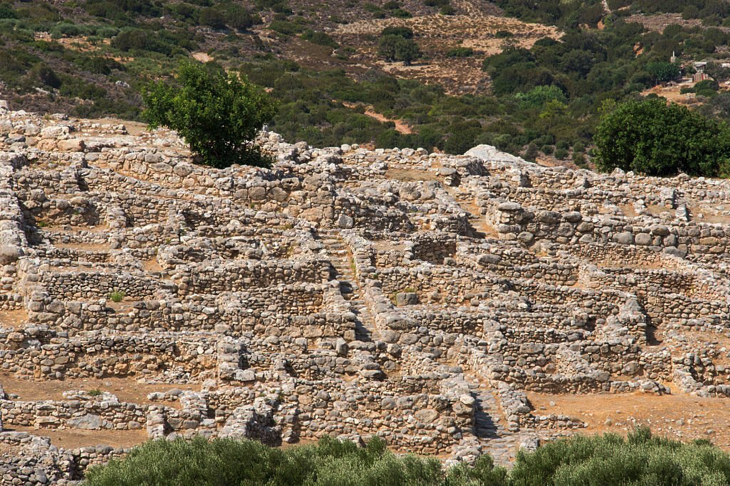
What are the artefacts found in the Gournia Archaeological Site?
Gournia Archaeological Site is one of the few entirely excavated Minoan villages. Gournia Archaeological Site was explored by Harriet Boyd in the first decade of the 20th century. Gournia Archaeological Site was discovered by Boyd and their team in 1901, where Boyd described the discoveries as “intramural burials”. However, later after the discovery, coining the term, “house tombs” was used to refer to it. Just like any other archaeological site, Gournia Archaeological Site offers historic importance by presenting artefacts that are equally important and play a role in establishing Gournia Archaeological Site as a must-visit archaeological site in Crete.
Listed below are the artefacts found in Gournia Archaeological Site.
- The Town: The town surrounded the central structure and covered the entire hill. At the base of the hill, a “cyclopean” wall with three towers was discovered. Access to the terraced, freestanding homes was provided by stone-paved streets, one of which went directly to the main structure. On the lower floor of the houses were storage areas and workshops, and on the upper story were the real living spaces.
- The Palace: The palace serves as the seat of the local government. On top of the hill, to the west of the rectangular court, on which many private homes are open, is the enormous palatial structure that serves as the seat of the local government. The palace serves as the town’s hub and perhaps its agora. On the south side of the structure, facing the court, there is a low set of L-shaped steps that are attached. The courtyard appears to have served as a primitive “theatre area” where people sat to watch ritualistic ceremonies.
1. The Town
The town surrounded the central structure and covered the entire hill. At the base of the hill, a “cyclopean” wall with three towers was discovered. Access to the terraced, freestanding homes was provided by stone-paved streets, one of which went directly to the main structure. On the lower floor of the houses were storage areas and workshops, and on the upper story were the real living spaces. The low hill’s slopes are where the undefended town expands. The town is divided into insulae by two paved outlying avenues that intersect at right angles with others that climb the hill’s slope and are frequently stepped. Seven of the insulae have already been excavated. The outer walls of the two-story homes are all the same. The underground rooms, accessed by wooden ladders from the upper floor, and the periodicals and workshops on the ground floor are still standing today. There is a staircase leading up to the upper floor, which is where the actual living space is, right from the street. Although the superstructure of the structures is made of mud bricks, the lower portions of the building are created with stone walls.
Below are sample images of The Town.
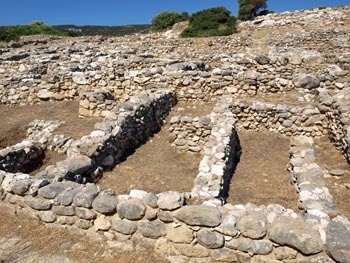
Structures in the town’s east part.
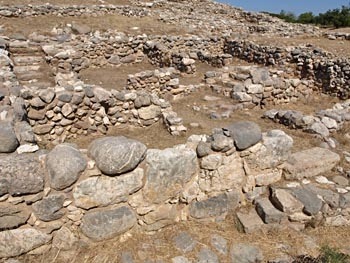
A house in the town.
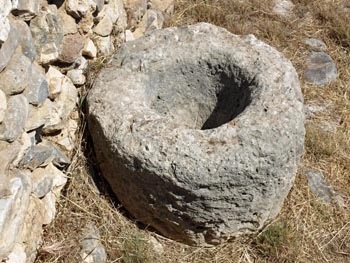
A pythio found in the town.
2. The Palace
The palace serves as the seat of the local government. On top of the hill, to the west of the rectangular court, on which many private homes are open, is the enormous palatial structure that serves as the seat of the local government. The palace serves as the town’s hub and perhaps its agora. On the south side of the structure, facing the court, there is a low set of L-shaped steps that are attached. The courtyard appears to have served as a primitive “Theatre area” where people sat to watch ritualistic ceremonies. A small room with a floor covered in stone with holes that were allegedly used as a platform for bull sacrifices and a “Kernos”, a small stone with hollows used for offering libations to the gods, can be found behind the stairs. The palace’s west side, which faced a small, paved west court, had a massive facade with recessed areas and outward extensions, a central door, and windows that have since been lost. Although the palace’s interior is not in great shape, it nevertheless contained a number of official chambers and magazines that were topped by large halls. The central court and the palace’s main hall were divided by a series of wooden columns and square stone piers. An unrelated, modest public temple honouring the Minoan “Snake Goddess” is located to the north of the palace.
Below are sample images of The Palace.
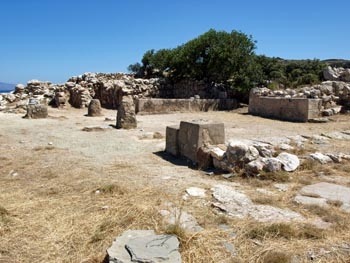
The Palace.
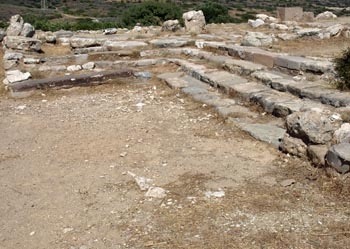
The “Theatre area”.
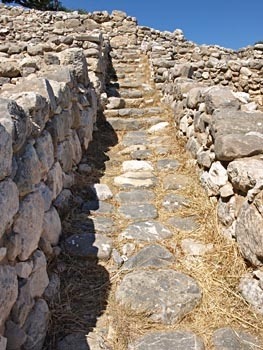
Steps leading to the Palace area.
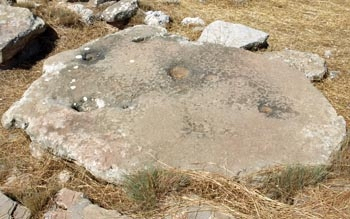
The “Kernos”, is a table for offering libations to the gods.
How was the Gournia Archaeological Site preserved?
Gournia Archaeological Site is preserved well. The initiative to preserve Gournia Archaeological Site is pushed by the Greek state to preserve and maintain the historic value of the Gournia Archaeological Site through reconstruction, reassembly, removal, and excavation, as well as site interpretation. In general, the Council of Europe, the legislation provides that from the beginning of the modern Greek State’s foundation, the preservation of cultural assets such as the Gournia Archaeological Site was a state duty. Law 3028/2002, “On the Protection of Antiquities and Cultural Heritage in General”, is the primary piece of legislation governing the protection of cultural heritage. It establishes a thorough and detailed system of protection regarding both movable and immovable monuments and artefacts, as well as the intangible heritage.
What are the nearby attractions in the Gournia Archaeological Site?
Gournia, in which the Gournia Archaeological Site is located, offers a rare chance to see daily life in a town that flourished between 1700 and 1450 BC. It was initially investigated by American archaeologist Harriet Boyd at the turn of the 20th century. Gournia Archaeological Site is a standout stop for exploring Crete Historical Sites, Landmarks, Points of Interest itinerary as well. Gournia Archaeological Site also has an adjacent tourist destination.
Listed below are the nearby attractions in the Gournia Archaeological Site.
- Moni Faneromeni: The Faneromeni monastery, which was built in the 16th century as a defence against the Ottoman Turk menace, resembles a defensive redoubt more than a cloister. From here, you can see the water in spectacular detail. In northeastern Crete, the Faneromeni monastery perches on, rather climbing to, a jut of cliffs that overlooks the sizable Bay of Mirabello. Despite being partially hidden by the grey-brown rock, it is visible from the wide coastal plain and the major road.
- Mirabello Bay: Mirabello Bay is a sea of Crete embayment located on the eastern coast of Crete in modern-day Greece. Mirabello Bay is the fifth-largest bay in the Mediterranean Sea and the biggest bay among the Greek islands. Agios Nikolaos, a tourist destination, has a view of the bay. This area had a significant role on the island of Crete’s prehistoric settlement.
- Pachia Ammos Beach: Pachia Ammos Beach is in front of the village of Pachia Ammos in Crete. Pachia Ammos Beach is 20 kilometres east of Agios Nikolaos and around 10 miles (16.09 km) from Ierapetra. It is a wind-exposed beach with coarse sand and rocks.
What are the nearby restaurants in the Gournia Archaeological Site?
Gournia Archaeological Site is strategically located not just for sightseeing, but also for tourists who are foodies in nature. Visiting historical places and learning about cultures, and appreciating ancient Crete are surely tiring and starving activities to do. But it is not a waste of energy, since the Gournia Archaeological Site has a lot more to offer, making it a must-visit site. When in Crete, make sure to check the 10 Best Restaurants in Crete and What they’re Known for, for a more complete Crete travel. Worry no more about where to eat when visiting the Gournia Archaeological Site, since it also has restaurants that are nearby the site that are ready to cater and serve you the best plate available.
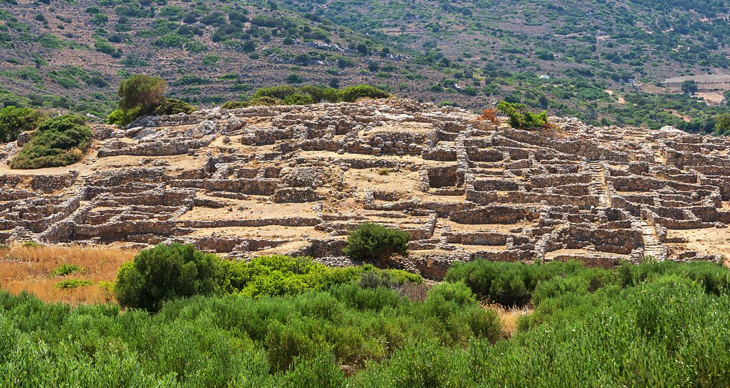
Listed below are the nearby restaurants in the Gournia Archaeological Site.
- Porto Kanaki: Porto Kanaki is just 0.7 miles (1.13 kilometres) from Gournia. Porto Kanaki is located in Pachia Ammos, Crete. The location of the restaurant is across from the beach, thus, offering you a scenic view while eating. Porto Kanaki serves seafood, Greek, and Mediterranean dishes. Moreover, Porto Kanaki is an authentic Cretan restaurant in Pachia Ammos offering excellent food, a great location, unbeatable service and a view right next to the sea. You can enjoy delicious Greek cuisine with fresh and natural dishes.
- Zorbas Tavern: Zorbas Tavern, located near the Pachia Ammos Beach in Pachia Ammos, Crete, is 0.7 miles (1.13 kilometres) away from Gournia. Serving you palatable Mediterranean and Greek cuisine, Zorbas Tavern is a must-try restaurant that is near the Gournia Archaeological Site. The welcome, the food, and the atmosphere in Zorbas Tavern are great. Situated just a few steps from the sea, the restaurant offers all the authentic dishes of Crete.
- Mermigas: 0.7 miles (1.13 kilometres) away from Gournia, you can find Mermigas. Mermigas is ready to serve you seafood, Mediterranean and Greek cuisine, grill, and diner dishes. Located in Pachia Ammos, Crete, a drive to Mermigas will give mouth-watering food. You can expect excellent service, fantastic food, and a great atmosphere in Mermigas.
What is the contribution of the Gournia Archaeological Site to Crete Tourism?
Gournia Archaeological Site contributes a significant amount to Crete Tourism. Tourists pay €2 for all regular tourists, and €1 for senior citizens and students upon visiting Gournia Archaeological Site. Greece’s largest island, Crete, is a diverse and energetic place full of historic sites, bustling cities, and gorgeous coastlines. Although many visitors come for the sun, sea, and sand, there is much more to do in Crete than what is usually included in vacation packages, such as visiting Gournia Archaeological Site for a historic experience. More than 5 million tourists arrived in Crete in 2018, accounting for nearly one-sixth of all visitors to Greece, and 20% of all tourism-related revenue was earned there. Following the threat of COVID-19, the number of tourist visits not just to the Gournia Archaeological Site but on the island of Crete has significantly slowed down. Thus, Covid-19 has affected the tourism industry, but countries and travel destinations are slowly opening and operating with the maximum safety possible to revive tourism.
What is the best way to get from the Gournia Archaeological Site?
Renting a car is the best way to get from Heraklion to Chania. Visiting Crete, in general, comes in handy and is convenient with a rented car, especially when visiting Gournia Archaeological Site. Going around Crete and visiting its magnificent and historic museums, archaeological sites, and other tourist destinations is just a breeze using a rented car. It is a lot more convenient and provides more flexibility in travel. Most car rental companies offer online booking for faster transactions. Car Rental Crete offers an easy way of renting a vehicle. Crete Car Rental is one of the prominent car rentals on the island. Car rental is the best way to get from Gournia Archaeological Site since it gives you independence during your trip. Renting a car to get to Gournia Archaeological Site will allow you a lot more freedom and flexibility during your schedule, likewise, allows you to reach the off-the-beaten-path beaches, villages, and churches that are not serviced by public transport. The greatest advantage that a car rental could give to a tourist wanting to get to Gournia Archaeological Site is flexibility and time control. Surely, every euro spent will be compensated by the comfort, convenience, and flexibility of renting a car.
Can you rent a car to get to the Gournia Archaeological Site?
Yes, renting a car is a necessity to get around Crete, especially when visiting Gournia Archaeological Site. Renting a car when visiting Crete is an advantage to go around the island and maximise time. There are tourist destinations in Crete that public transportation does not stop at. Public transportation sometimes only stops at the nearest station to these attractions, so tourists take a taxi to take them to their destination. Thus, Car Rental Crete should be considered when planning to visit the island, especially when planning to go around different archaeological sites such as Gournia Archaeological Site for a better experience, convenience, and appreciation of the destinations by travelling exclusively.
What are the factors to consider before renting a car in Crete?
There are buses and taxis available that tourists can use to travel around Crete. But another type of transportation is car rental, which is a more private mode of transportation. Car rental, most of the time, is a must when going around and travelling in Crete. Tourists need a car for them to be able to reach tourist destinations they wish to visit. There are different car rental companies that tourists can opt to rent their car in Crete during their stay. It is a great option for those who want to have private transportation when going to their destination, especially during the pandemic.
Listed below are the things to consider before renting a car in Crete.
- Insurance: Make sure that the car has insurance that will cover the damage that may be caused by any possible accidents.
- Driver’s Age: The driver should be at least over 21 years old and has a driver’s licence for 12 months.
- Driver’s Gender: Some tourists can be picky regarding who will be their driver. The gender of the driver is one of the things that tourists consider, as many people believe that men are better drivers than women.
- Car Type: There are different car types that are available to be rented. Each type caters to a different number of passengers and the amount of bags they can carry.
- Documents: Other than having a driver’s licence, an ID card or passport, a debit or credit card is required to rent a car. The card with the driver’s name is needed to provide the rental car company guarantee.
How much does a car rental in Crete cost?
Crete Car Rental costs depend on how many days that car will be rented, the number of passengers, and the type of car that will be rented. Crete Car Rental for a week can cost around €250. Day trips and night trips in Crete will cost about €30 to €40. It can be used for a week with unlimited mileage and four-seaters. The rental cars are manual transmission, air-conditioned, and have four doors. The rented car should be returned to the company with the same amount of fuel as at the start of the trip to avoid charges.
Are children permitted at the Gournia Archaeological Site?
Yes, children are permitted at the Gournia Archaeological Site, but parents are encouraged to be vigilant about the children’s actions to preserve and protect the artefacts that are available at Gournia Archaeological Site. As Gournia Archaeological Site provides you with the best view and scenery perfect for picture taking, children can surely enjoy the view and the ambience of the place. Taking the tour of the Gournia Archaeological Site is a fun activity for the children when visiting Crete. However, there are other Fun Places in Crete to Take Your Kids for a memorable, fun-filled, worthy, and enjoyable visit in Crete.
